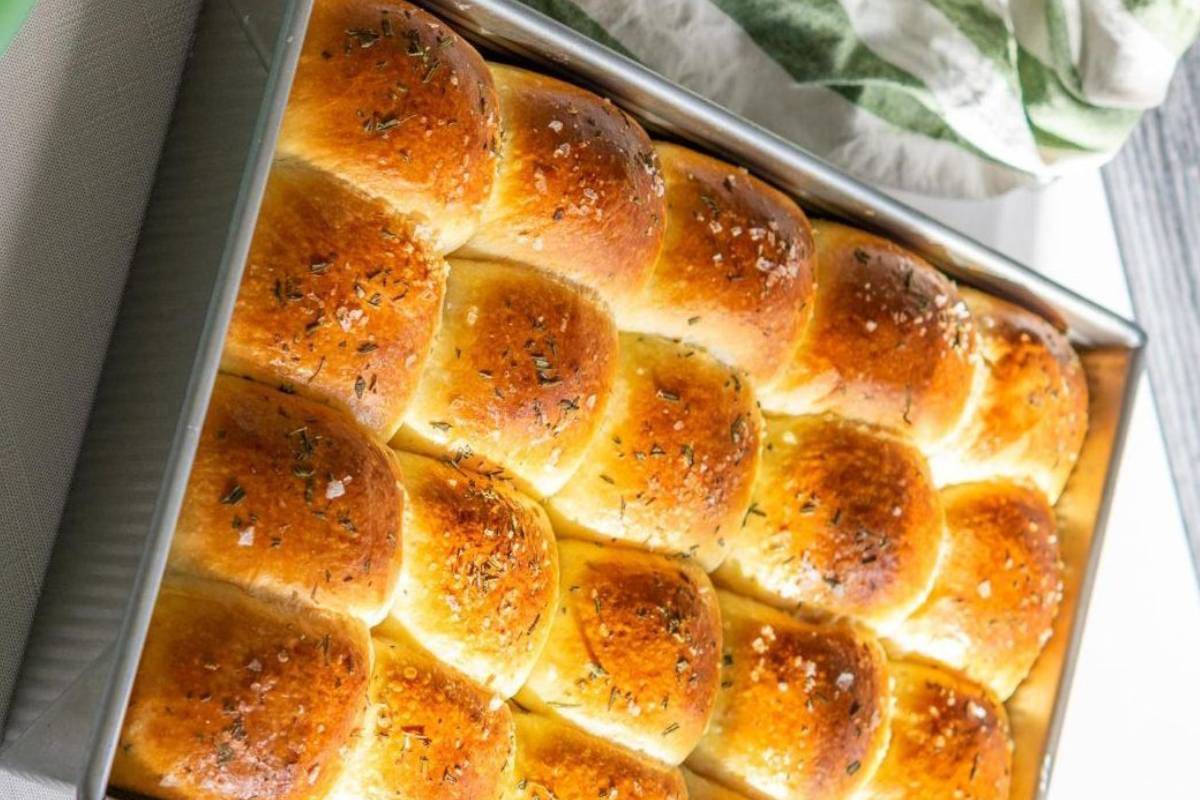Table of Contents
Perfectly Pillowy Sourdough Rolls Recipe
Sourdough rolls are the epitome of comfort food, offering a delightful texture and a hint of tang that can elevate any meal. Whether you’re enjoying them with a savory stew, slathering them with butter, or using them to make a delicious sandwich, these rolls are sure to impress. The process may seem daunting, but with a bit of patience and practice, you’ll create beautifully airy, perfectly pillowy sourdough rolls that your family and friends will rave about. Let’s dive into the world of sourdough baking!
1. Understanding Sourdough
Sourdough is a type of bread made using a natural leaven, or starter, that contains wild yeast and lactic acid bacteria. This starter ferments the dough, providing it with a unique flavor and texture that commercial yeast cannot replicate. The key to great sourdough rolls lies in a well-maintained starter, the right ingredients, and a good understanding of the fermentation process.
2. Ingredients Needed
For this recipe, you will need the following ingredients:
- For the Dough:
- 500g (4 cups) all-purpose flour
- 300g (1 1/4 cups) water, at room temperature
- 100g (1/2 cup) active sourdough starter
- 10g (2 teaspoons) salt
- 30g (2 tablespoons) sugar (optional for sweetness)
- 50g (1/4 cup) unsalted butter, softened (optional for richness)
- For Topping (optional):
- Melted butter for brushing
- Sesame seeds, poppy seeds, or flaky sea salt for sprinkling
3. Equipment Required
To make these rolls, you’ll need:
- A large mixing bowl
- A kitchen scale for accurate measurements
- A bench scraper
- A baking sheet
- Parchment paper or a silicone baking mat
- A clean kitchen towel or plastic wrap
- A baking stone or Dutch oven (optional for enhanced crust)
4. Making the Dough
- Activate Your Starter: Make sure your sourdough starter is lively and bubbly.. Feed it 4-6 hours before starting your rolls, depending on the temperature of your kitchen.
- Mix Ingredients: In a large mixing bowl, combine the flour and sugar (if using). In another bowl, mix the water and the active sourdough starter until dissolved. Gradually add the wet ingredients to the dry ingredients, using a spatula or your hands to bring it together into a shaggy dough.
- Add Salt and Butter: Once the dough is roughly combined, sprinkle the salt on top and knead it into the dough. If using butter, add it after the salt and knead until fully incorporated. The dough will be sticky at this point, which is normal for sourdough.
- Knead the Dough: Turn the dough out onto a lightly floured surface and knead for about 10-15 minutes, or until it becomes smooth and elastic. If the dough is too sticky, sprinkle a little flour as needed, but be careful not to add too much.
5. Shaping the Rolls
- First Rise: Transfer the dough back to the bowl and cover it with a clean kitchen towel or plastic wrap. Allow it to rise at room temperature for 4 to 6 hours, or until it has doubled in volume.
- Pre-shape: Once the dough has risen, gently turn it out onto a floured surface. Divide the dough into 12 equal pieces using a bench scraper. Pre-shape each piece into a loose ball by tucking the edges into the center and rolling it on the countertop.
- Bench Rest: Cover the pre-shaped dough balls with a towel and let them rest for about 20-30 minutes. This allows the gluten to relax, making them easier to shape.
- Final Shape: After resting, take each ball and shape it into a tighter roll. To do this, gently flatten the ball, fold the edges towards the center, and roll it tightly into a smooth ball. Place each roll seam-side down on a parchment-lined baking sheet, leaving space between them for expansion.

6. Fermentation and Proofing
- Second Rise: Cover the rolls loosely with plastic wrap or a towel and let them proof for 2-4 hours at room temperature, or until they have puffed up nicely. Alternatively, you can place them in the fridge overnight for a slower fermentation, which enhances the flavor.
- Check for Readiness: To determine if the rolls are ready to bake, gently poke one with your finger. If the indentation springs back slowly, they are ready. If it bounces back quickly, they require additional time to proof.
7. Baking the Rolls
- Preheat the Oven: Preheat your oven to 450°F (230°C). If you’re using a baking stone, place it in the oven to heat up as well.
- Bake: Once the oven is hot, bake the rolls for 20-25 minutes, or until they are golden brown and sound hollow when tapped on the bottom. If you want an extra crispy crust, you can add a pan of water to the oven for steam during the first 10 minutes of baking.
- Cool: After baking, remove the rolls from the oven and transfer them to a wire rack to cool. Brush with melted butter for added flavor, if desired.
8. Serving Suggestions
These sourdough rolls are incredibly versatile and can be served in various ways:
- As a Side Dish: Serve them warm alongside soups, stews, or salads for a comforting meal.
- For Sandwiches: Slice them in half and fill them with your favorite sandwich ingredients, such as deli meats, cheeses, or roasted vegetables.
- With Spreads: Enjoy them with butter, honey, jam, or your favorite spreads for a delightful snack or breakfast option.
- As a Base for Sliders: Use them as mini buns for sliders filled with pulled pork, chicken, or veggie patties.
9. Storage and Freezing Tips
- Room Temperature: Store any leftover rolls in an airtight container at room temperature for up to 2 days. If they start to harden, you can revive them by warming them briefly in the oven.
- Freezing: To freeze the rolls, allow them to cool completely, then place them in a freezer bag or airtight container. They can be frozen for up to 3 months.To enjoy, thaw them in the refrigerator overnight, then heat them in the oven before serving.
10. Troubleshooting Common Issues
- Dense Rolls: If your rolls are dense, it could be due to an inactive starter, not enough fermentation time, or too much flour added during kneading.
- Flat Rolls: If the rolls flatten out during proofing, they may have been over-proofed or lacked sufficient gluten development. Ensure you’re kneading well and keeping an eye on proofing times.
- Tough Crust: A tough crust may indicate that the rolls were baked too long or at too high a temperature. Use an instant-read thermometer to check that the internal temperature reaches about 190°F (88°C) for perfectly baked rolls.
11. Final Thoughts
Baking sourdough rolls may take some practice, but the end result is well worth the effort. With a little patience and the right techniques, you’ll be able to create perfectly pillowy sourdough rolls that are sure to become a favorite in your home. Whether for a special occasion or just a cozy family dinner, these rolls are a delicious way to enjoy the art of sourdough baking.
Conclusion
In conclusion, making perfectly pillowy sourdough rolls is a rewarding culinary adventure that yields delicious results. The rich flavors and satisfying textures are sure to impress your loved ones. By following this detailed recipe and embracing the process of sourdough baking, you’ll be well on your way to mastering this delightful skill. Enjoy your baking journey and relish the joy that these homemade rolls bring to your table!
FAQ About Sourdough Rolls Recipe
1. What makes sourdough rolls unique?
Sourdough rolls are special because they use natural fermentation to rise instead of commercial yeast. This fermentation process gives them their distinct tangy flavor and a chewy texture. Moreover, sourdough is often easier to digest and can have added nutritional benefits compared to regular bread.
2. Do I need a sourdough starter to make sourdough rolls?
Yes, a sourdough starter is essential for making sourdough rolls. The starter provides the natural yeast and bacteria needed for fermentation. If you don’t have one, you can easily create your own by combining flour and water and letting it ferment over several days.
3. How long does it take to make sourdough rolls?
The process is longer than with regular rolls because sourdough needs time to ferment and proof. For instance, after mixing the dough, it typically requires a bulk fermentation of 4-8 hours, followed by shaping and a final proofing period. While this takes time, the result is well worth the wait!
4. Can I speed up the process?
Unfortunately, the slow fermentation is what gives sourdough its flavor and texture. However, if you want to prepare in advance, you can let the dough proof overnight in the refrigerator. This not only saves time on baking day but also enhances the flavor.
5. What can I pair with sourdough rolls?
Sourdough rolls are versatile and pair well with a variety of dishes. For example, they can be served with soups, stews, or salads. Additionally, you can enjoy them as sandwich rolls or simply with butter and jam for a delightful snack.

